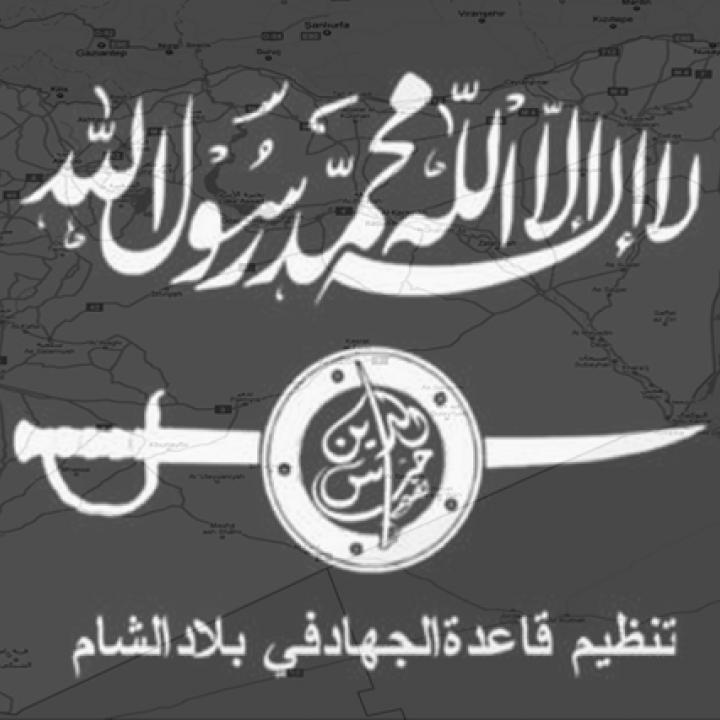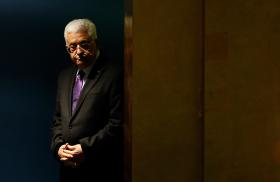
- Policy Analysis
- PolicyWatch 3188
Huras al-Din: The Overlooked al-Qaeda Group in Syria

Although it still relies on its stronger rival to operate, the ascendant affiliate has been cementing its presence in Idlib province, attracting other factions to its banner, and potentially setting itself up to lead a future insurgency.
In recent weeks, the State Department has formally designated Huras al-Din (Guardians of Religion) as a Foreign Terrorist Organization and placed “Rewards for Justice” bounties on three of its leaders. The group (hereinafter HD) is al-Qaeda’s official branch in Syria, a role it assumed after Hayat Tahrir al-Sham (HTS) publicly distanced itself from its original parent organization. Meanwhile, senior HD figure Abu Khaled al-Muhandis (aka Suhayb) was killed in late August, the victim of an improvised explosive device planted by rival Islamists.
Given these developments, it is important to look beyond HD’s ideological differences with HTS and explore what its members are actually doing in northwest Syria, the country’s remaining bastion for jihadist groups. If the Assad regime and its allies decide to make further incursions into Idlib province or retake it entirely, HD could be well placed to take advantage. By framing such developments as proof that its rivals have failed—the Islamic State in trying to monopolize territory, and HTS in trying to deepen local roots and establish a modus vivendi with Turkey—HD could convince more jihadists to join its ranks and help it lead a future insurgency in north Syria.
COMPOSITION AND MILITARY OPERATIONS
Founded in February 2018 after al-Qaeda’s original branch in Syria broke away, HD is guided by several key figures, including overall leader Khaled al-Aruri (aka Abu al-Qasim al-Urduni) and shura council members Samir Hijazi (aka Abu Hamam al-Shami or Faruq al-Suri), Sami al-Uraydi (aka Abu Mahmud al-Sham), Bilal Khuraysat (aka Abu Hudhayfah al-Urduni), Faraj Ahmad Nanaa, and Abu Abd al-Karim al-Masri. Its founding statement urged “the fighting factions in al-Sham to stop fighting among themselves and save the tent of Muslims.” In response to that unifying plea, at least sixteen factions joined HD:
- Jaish al-Malahim
- Jaish al-Sahil
- Jaish al-Badiyah
- Saraya Kabul
- Saraya al-Ghutah
- Katibat Abu Bakr al-Sadiq
- Katibat Abu Ubaydah bin al-Jarah
- Saraya al-Ghuraba
- Katibat al-Batar
- Saraya al-Sahil
- Saraya Abd al-Rahman bin Awf
- Kataib Jund al-Sham
- Kataib Fursan al-Iman
- Quwat al-Nukhbah
- Majmuah Abd Allah Azzam
- Katibat Usud al-Tawhid
HD publicized these additions far and wide in the weeks that followed, seeking to show that it had a local support base and was not a solitary fringe actor. Since then, it has set up at least four training camps for these fighting forces.
To further enhance its strength and military capacity, HD has also established different fighting alliances. The first came in April 2018, when Ansar al-Tawhid and HD formed Hilf Nusrat al-Islam. Even more consequential was the October 2018 creation of the Wa-Hardh al-Muminin Operations Room, alongside two smaller al-Qaeda-aligned groups: Jabhat Ansar al-Din and Jamaat Ansar al-Islam.
Whether as part of these alliances or as an independent actor, HD claims to have mounted around 200 attacks since it was created. They occurred in a variety of rural areas and small towns, including twelve locations in Aleppo province, sixteen in Hama province, seven in Idlib province, and fifteen in Latakia province. Interestingly, at least three of these claimed attacks were conducted jointly with HTS, suggesting that their relationship is more of the “frenemies” type than purely hostile. In a January 2019 interview with British doctoral student Aymenn al-Tamimi, HTS fighter Abu al-Laith al-Halabi noted that “HTS is the one that provides expenditures of food and ammunition for [HD] on a daily basis.” And in a July 2019 interview, an HD recruit from Germany said, “Our problem is just with the leaders of HTS. The lower ranks are guys like us.”
DAWA, HISBA, AND FUNDRAISING
Besides military activities, HD is deeply involved in spreading its ideology in different parts of Idlib province. It has built up a clerical establishment via its Duat al-Tawhid al-Dawai Center, which is led by Abu Usamah al-Shawkani. Other key figures in its religious outreach include Abu Hurayrah al-Shami, Abu al-Bara al-Muhahir (aka al-Tunisi), Abu Adnan al-Shami, Abu Muhammad al-Shami, Qaswarah al-Shami, and Abu Abd al-Rahman al-Maki. The center’s activities focus on Friday sermons, youth lectures, public dawa (outreach) forums, dawa tours, cultural courses, and hospital visits. Members also distribute ideological literature at car checkpoints and hang banners advertising their ideology or events.
Since its founding, HD has used online resources to promote up to 100 such events in fourteen different cities and villages in Idlib. Many more have likely been held but only publicized locally. In addition, the Duat al-Tawhid al-Dawai Center opened a summer school for children age 5-10 in Sahl al-Rouj, providing free transportation, Arabic/English-language instruction, religious studies (the Quran, hadith, and sharia), and sports activities.
HD has also established a “Committee for Commanding Right and Forbidding Wrong.” Among other activities, committee members conduct hisba patrols (i.e., moral policing) and distribute sharia-compliant clothing to schoolgirls in line with HD’s interpretation of modesty.
Moreover, HD and its Wa-Hardh al-Muminin Operations Room have raised funds for military activities locally and online as part of their “Jahizuna Campaign,” whose guiding principle states that “Money is the backbone of jihad, and the abilities of the mujahedin would be weakened without it.” The funds are used for weaponry (e.g., AK-47s, bullets, rocket-propelled grenades), food, fuel, and medical treatment for wounded fighters. The campaign began in mid-May, asking supporters to send messages to dedicated Telegram and WhatsApp accounts, which then provide them with bank account information where they can send funds. This suggests that HD officials may have at least some access to the global financial system, presumably through front accounts just across the border in Turkey.
WATCHING OUT FOR FUTURE INSURGENCY
Despite this surge of military and social activity, HD is not the strongest actor in Idlib province—it still depends on HTS to operate, and if it were to grow significantly stronger, HTS may try to suppress it and arrest its leaders in order to preserve its own power base. In that sense, HD’s local growth potential is somewhat limited. The situation is part of the broader conundrum that often arises with al-Qaeda franchises: as they become larger and more popular, they must choose between staying true to their core ideology or becoming more pragmatic in order to maintain local power and legitimacy. This dilemma is the main reason why HTS distanced itself from al-Qaeda, forcing its former parent group to build up HD as a new franchise.
For now, the most important question for U.S. policy is whether these dynamics will push HD toward more external operations planning. The U.S. intelligence and military communities should continue monitoring developments in the group’s known areas of operation, and U.S. forces should conduct discriminant airstrikes when deemed necessary, as they have done with other al-Qaeda-linked figures in northwest Syria. Washington should also track wider developments in Idlib province to determine whether forces connected to the Assad regime are planning a future takeover there, since the collapse of that corridor could position HD to lead the next major jihadist insurgency.
Aaron Zelin is the Richard Borow Fellow at The Washington Institute and a Visiting Research Scholar at Brandeis University. His publications include the forthcoming book Your Sons Are at Your Service: Tunisia’s Missionaries of Jihad (Columbia University Press).



